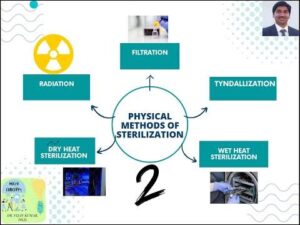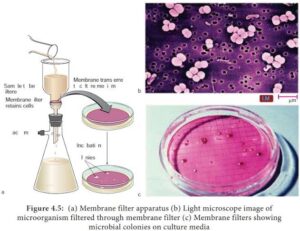Back to: MICROBIOLOGY 100 LEVEL
Welcome to class!
I’m always happy to see you show up, ready to learn and grow. You’re not just studying microbiology—you’re understanding life, health, and how the tiniest things around us work. Today, we’ll look at some smart and powerful ways we control and eliminate microbes—using heat, radiation, and filtration. These methods are essential in hospitals, labs, and even in our homes. Ready? Let’s take it step by step.
Heat, Radiation, Filtration
Let’s start with something very familiar: heat. Think about when your mum boils water before cooking rice or disinfects baby bottles with hot water. That’s not just for cleanliness—it’s killing microbes. Just like that, scientists and doctors use heat, radiation, and filtration to remove or destroy harmful microorganisms.

These methods are part of what we call physical methods of microbial control. Unlike drugs, which work inside the body, these ones are used outside—on instruments, air, surfaces, or liquids—to prevent infection.
Heat
Heat is one of the most common and effective ways to kill microbes. It works by destroying proteins and enzymes in the microorganism—once those are gone, the cell can’t survive.
Types of Heat Methods:
Moist Heat
This includes boiling, autoclaving, and pasteurisation. Moist heat works faster than dry heat because water conducts heat better.
Boiling kills most bacteria, fungi, and viruses in about 10 minutes.
Autoclaving (steam under pressure) is used in hospitals and labs to sterilise equipment. It reaches 121°C at 15 psi for 15–20 minutes—enough to kill even spores!
Pasteurisation is used for milk and juice. It heats liquids just enough to kill harmful microbes without spoiling the food.
Dry Heat
Used for things that can’t get wet (like glassware or metal instruments). It includes:
Hot air ovens (160–180°C for 2 hours)
Incineration (burning)—used for waste like used syringes or infected dressings.
Radiation
Radiation uses energy waves to kill or damage microorganisms. It’s like sunlight burning your skin—except this is more intense and controlled.
Types of Radiation:
Ionising Radiation
This includes X-rays and gamma rays. It penetrates deeply and damages DNA, making it perfect for sterilising medical equipment and food products.
Non-ionising Radiation
Ultraviolet (UV) light is the most common type. It damages the DNA of microbes, but it doesn’t go deep—so it’s mainly used to disinfect air, surfaces, or water (like in water treatment plants).
Filtration
Now, what if you need to remove microbes from a liquid or air without killing them? That’s where filtration comes in. Imagine using a sieve to separate stones from rice—filtration works the same way, but with very tiny pores.
Types of Filtration:
Liquid Filtration
Used for solutions that can’t be heated, like vaccines, enzymes, and some antibiotics. Filters are made of materials like cellulose and have pores small enough to trap bacteria.

Air Filtration
HEPA (High-Efficiency Particulate Air) filters are used in operating theatres and clean rooms to trap airborne microbes.
Summary
- Heat kills microbes by destroying proteins. Moist heat (like autoclaving) is faster than dry heat.
- Radiation damages microbial DNA. Ionising radiation is used for deep sterilisation; UV light is for surfaces and air.
- Filtration removes microbes from liquids or air without killing them. It’s useful for heat-sensitive materials.
- These methods are important for sterilising equipment, disinfecting environments, and making products safe.
Evaluation
- What is the difference between moist heat and dry heat in microbial control?
- Name one example of ionising radiation and explain how it works.
- Why is filtration used instead of heat for some solutions?
Each topic you complete takes you one step closer to being a top-notch microbiologist. Keep believing in yourself and know that Afrilearn is with you every step of the way. You’ve got this—and I’ll see you in the next exciting lesson!
